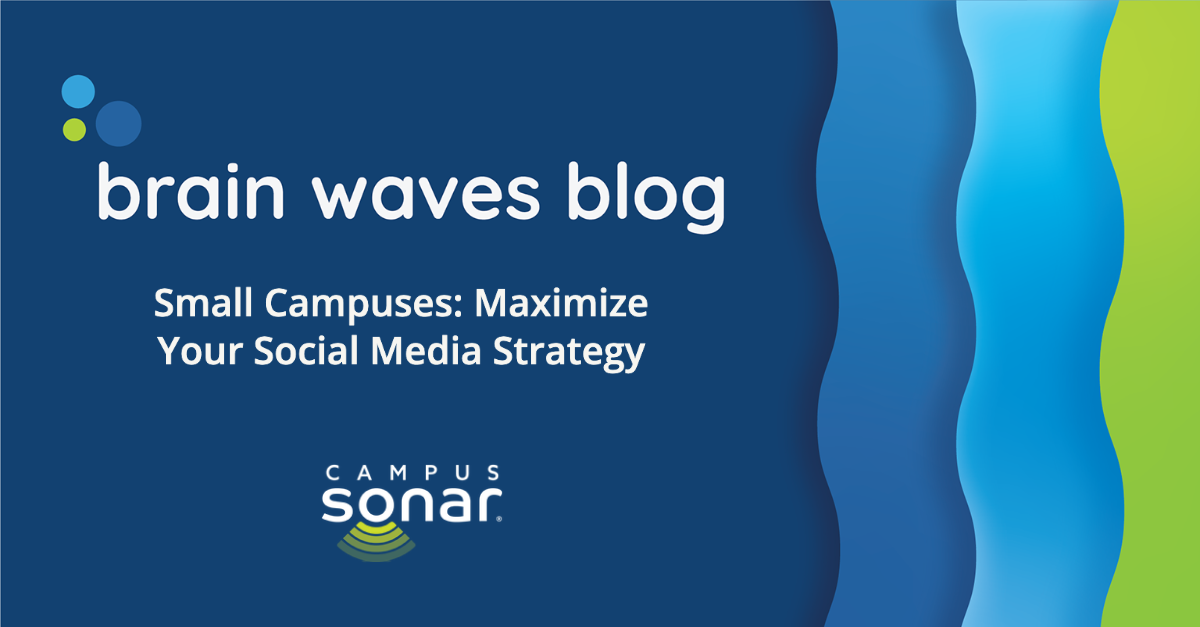Small Campuses: Maximize Your Social Media Strategy

If you work on a small campus, chances are you’re a master at multitasking. Depending on the size of your campus, social media may be the responsibility of one person, or less than one, so it’s important to get the most out of everything you do. If that’s where you sit right now, we can help.
Over the last five+ years of researching higher ed conversation, we’ve discovered small campuses have an amazing opportunity to differentiate themselves. There’s a lack of consistency among small campuses that doesn’t exist for larger campuses. If you’re heading a small marketing team, the post-pandemic changes provide space for you to stand out in a crowded market.
Revisit Your Content Strategy
There’s an overall trend that campuses are creating more original content, but generating fewer shares/retweets and comments/replies than the fall 2020 semester. Smaller campuses post much more original content than large campuses. But there’s little social listening evidence that this leads to greater awareness because we don't see a benefit in terms of larger earned conversation. As a small campus, Liz Gross shares that “you can’t win the content creation arms race,” but you can increase visibility where it matters most—with individual engagement, greater brand awareness, and increased affinity for your campus.
- Have your team pull back on the content calendar. Success for content can only be measured with vanity metrics, which align with the platform’s goals rather than your campus goals. As you realign your social strategy, include less original content, or from fewer accounts. Content production isn’t where you’ll see success with your social strategy.

- Shift your focus to engagement and find success by focusing on the individual moments when you engage with your community. At a minimum, have your team reply to people who mention any of the accounts associated with your campus. Once that standard is set, work to proactively engage with people who talk about you, but not to you—the posts you’ll find only through social listening.
- The shift to engagement also allows you to concentrate on what you can control. You can’t compel others to engage with your content, but you can find and engage with the people who matter to your campus. A comment or reply is an opportunity to directly engage with an individual and build affinity for your campus. And since replies are typically 1%–2% of owned content at a 4-year campus, you probably have some room to grow.
- Encourage your team to spend time on forums. Small campus conversation is increasing on forums by an average of 300%. You’re used to seeing your audience flocking to Twitter and Facebook to complain and celebrate, but they use forums to share more nuanced conversation under the veil of anonymity. Forums are a good way for your team to get the pulse on what your different audiences may think and feel. Include monitoring the conversation about your campus on forums like Reddit and College Confidential in your updated strategy.
- Athletics can increase the awareness of your campus to a non-athletic audience. It’s also an opportunity to differentiate yourself from peers without an athletics program. Harness that power in your strategy by weaving brand pillars and non-athletics strategic messaging into athletics conversation to increase awareness and overall brand alignment. Have your team foster relationships with colleagues so you can share these athletics stories with a wider audience.
Realign Your Budget
Small campus generally means smaller team sizes and budgets, but realigning your budget and resources can help. Adjusting your content strategy only required shifting your team’s focus and the same is true with your budget. As you’re able, adjust your funding and work toward focusing your resources on where they make the most impact.
- Creating large amounts of owned content requires a plethora of resources. We’ve found that small campuses typically develop original owned content at double the rate of larger campuses. Realign some of these resources and invest in the audience engagement strategy. Have your time allocate more time to communicating with your audience via comments and replies, monitoring forums, and building relationships so the content you do create is what your audience wants. This in turn increases conversations with your target audience and the amount of engagement opportunities and positive conversation. It’s a win-win for a small campus team.

- As you’re able, allocate budget resources to widen the gap with your competitors. When a campus invests in social media, the results in our data and they’re obvious for small campuses. We see major differences between small campuses on metrics like conversation volume, the number of unique authors, and where conversation takes place. This is an opportunity for your campus to build awareness and affinity for your brand.
- If your campus already invests in social media, double down on those efforts. Take advantage and put some space between you and your competitors.
- If investment is lacking on your campus, advocate for resources before the gap between you and your competitive set widens. Gaps in awareness and affinity mean you’ll spend more to accomplish key financial tasks, such as building your class or fundraising.
- If you need more budget, build a list of the things you would need to seize some of the opportunities you identified. Along with your list, consider how the added positions or financial power impact your outcomes as a department. You’re asking for added investment and you need to show a return on that investment. Communicate what your team could deliver that impacts the bottom line or contributes to aspects of your strategic plan.
Adjusting your team priorities to align with your campus goals will help you see success with increased brand awareness. If you’re looking to expand even more, consider how to assess and improve brand alignment, build team capacity, and collaborate with key units to move strategies forward based on audience and brand data. These are just a few ways our expertise can support your team so you can focus on the work that makes the biggest impact.
Engage with Your Audience
Understand why it's important to engage with your audience, along with actionable and approachable strategies for engaging with your audience.
